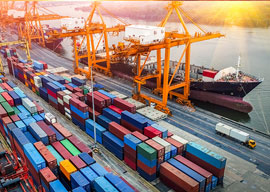EXiM trade data gather and consolidate the cross-border commerce and import-export trade of more than +230 markets across the globe to provide access to Global Import-Export Data.
Making EXiM trade data one of the best and largest international import-export trade database services providers in the world.
We at EXiM trade data provide assistance to various businesses ranging from manufacturers, Importers, Exporters, research companies, brokers, banks, and logistics & shipping companies to expand and take their business to a greater level. Get instant access to the world’s import-export data with EXiM trade data.
Market Analysis Of Turkey Trade Statistics
Turkey trade statistics is a collection of data that is recorded and based on factual information such as invoices, import-export bills, shipping bills, and some other import-export documents required across international borders for trading goods.
The analysis we provide on Turkey import-export data is sourced from Government Bodies, Logistics & Shipping Companies, Authorized Indian Customs Departments, Port Authorities, and some other authorized links.
Turkey Import Data Year Wise
➢ In the year 2019, Turkey’s Import was $249.30 billion, an increase of 2.6% compared to the year 2018.
➢ In the year 2020, Turkey’s import was $205.73 billion, a decline of 17.48% compared to the year 2019.
Top Imports Of Turkey And Its Major Import Partners
Optical Photographic, Medical Equipment (2.1%), Pharma Products (2.2%), Machinery (11.5%),
Pearls and Precious Stones (12.1%), Electrical Machinery and Equipment (7.8%), Iron and Steel (6.8%), Plastics (5.3%), Organic Chemicals (2.6%), Vehicles (6.9%), as per Turkey’s Import trade statistics.
Based on the market research reports and Turkey’s Import data United Arab Emirates (USD 5.6 billion), Germany (USD 21.7 billion), South Korea (USD 5.7 billion), Russia (USD 17.8 billion), Italy (USD 9.1 billion), Iraq (USD 8.2 billion), Switzerland (USD 7.7 billion), France (USD 6.9 billion), United States (USD 11.5 billion), and China (USD 23.0 billion) are some of the major import partners of Turkey.
Looking Into Indonesia Export Data & Its Export Statistics
Indonesia export data is a collection of data that is recorded and based on factual information such as invoices, import-export bills, shipping bills, and some other import-export documents required across international borders for trading goods
The analysis Exim provides on Indonesia import-export data is sourced from Government bodies, Logistics & Shipping Companies, Authorized Indian Customs Departments, Port Authorities, and some other authorized links.
Top Exports Of Indonesia And Its Major Export Partners
Iron & steel ($7.3 billion), Electronics ($9 billion), Animal -Vegetable Fats & Oils ($17.6 billion), Vehicles ($8.1 billion), Mineral Fuels & Oils ($34.1 billion) are some of the top imports of Indonesia.
According to the market research reports and Indonesia Export Data Philippines (4%), Singapore (7.7%), India (7.1%), Thailand (3.7%), South Korea (4.3%), Vietnam (3.1%), Malaysia (5.2%), Japan (9.5%), the United States of America (10.7%), China (16.7%) are some of the top export partners of Indonesia.







